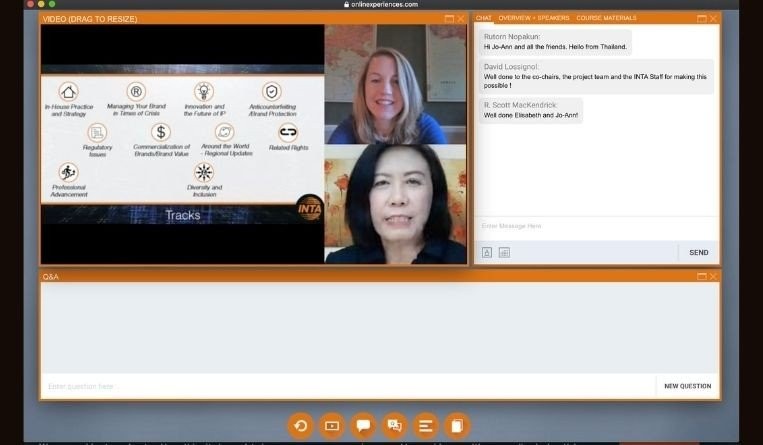INTA launches virtual annual meeting
16 November 2020

Elisabeth Bradley, vice president of innovation law at Bristol-Myers Squibb in Princeton, New Jersey, and Jo-Ann See, a director at Amica Law in Singapore, open INTA’s 2020 annual meeting, the organization’s first-ever virtual annual meeting.
November 16, 2020 — When the International Trademark Association’s 142nd Annual Meeting opened this morning, the event, which is occurring virtually for the first time in the organization’s history, was reminiscent of opening ceremonies of the past.
Though Covid-19 kept the meeting’s 3,300-plus participants at home, many of them sitting in their home offices, the association put together an opening ceremony that sounded, felt and looked very familiar.
Jo-Ann See, a director at Amica Law in Singapore, and Elisabeth Bradley, vice president of innovation law at Bristol-Myers Squibb in Princeton, New Jersey, opened the meeting with the same sort of good humor regular INTA attendees would expect to find on the stage. This year’s annual meeting was initially planned to take place in Singapore in April and was shifted to Houston in November as the pandemic took hold, before eventually moving to the all-online format that launched today.
While the largest parts of the meeting are taking place live on New York time, See noted that INTA has taken advantage of the meeting’s virtual platform by offering a China-focused track on China time, and “watch parties” of archived live sessions in other time zones, which will allow attendees to watch and comment on the session through the meeting platform’s chat feature.
And, indeed, the chat feature did make the opening session and keynotes feel almost as interactive as if we were all there in person. “The journey to get here has been an extremely complex one,” said INTA CEO Etienne Sanz de Acedo. “But here we are, all together. And we have transformed a huge challenge into an incredible set of opportunities. We’re all here. We remain together, and we remain a very strong community.”
Daren Tang, director general of the World Intellectual Property Organization – who had planned to welcome delegates to Singapore as chief executive of the Intellectual Property Office of Singapore “for chicken rice and laksa” – joined instead from Geneva. He assumed his role as head of WIPO on October 30.
As Tang took the virtual stage, supportive comments rolled in on the chat feature from around the world – including from lawyers in Manila, Bangkok, Delhi, Taipei and elsewhere in Asia, despite the fact that his keynote address kicked off around 11 pm Hong Kong time.
Tang called for INTA and WIPO to work together to broaden the conversation of IP beyond its legal and technical experts to include people outside the IP community, including policymakers, economists and industry leaders.
“We now need to look at IP from a broader economic perspective, to see how it can create jobs, how it drives enterprise growth, how it attracts investment and how at the larger level, it drives economic development and even supports social vibrancy,” Tang said.
Tang said that as WIPO director general, he intends to build a balanced and inclusive international IP ecosystem. “For too long, IP is still being seen as something that only supports the very big companies, supports the biggest brands and supports the most advanced economies, and that’s not true,” he said. “Coming from Singapore, coming from Southeast Asia, coming from Asia, where we have seen how IP is such an important tool for economic development, the message that goes out must be that IP is relevant to all parts of the world. IP is relevant to entrepreneurs in Africa, to the brand owners in Latin America, to the creators and musicians in every part of the world.”
Duncan Wardle, former vice president of innovation and creativity at The Walt Disney Company and now an Orlando, Florida-based speaker and innovation and creativity consultant, spoke of the importance of brands shifting their strategies as consumers shift what they’re looking for.
Wardle spoke of a talk he gave recently to the world’s largest manufacturer of tools. “I didn’t know much about their business, I didn’t understand their consumers, so I went down to the two of the biggest do-it-yourself stores in the United States, and I hung out for two days just watching and listening to their consumers at the point of purchase. I went back to talk to this company and said, listen, these consumers, this Generation Z, they don’t talk about your brand, they don’t talk about your products, the hammers or the chisels or the saws, and they’re not even talking about the price point. What they’re talking about is what’s important to them: ‘We’re going to build our dream house, our dream bathroom, our dream kitchen.’ I said to them, if you choose to create a purpose, your brand could be ‘we’re the brand that helps people build their dreams.’ And you could see the finance guys rolling their eyes, saying ‘well, how’s that going to help generate business for us?’ If you’re the brand that can help people build their dreams, could you be sports, entertainment, hospitality, banking, finance? You could be in any line of business that you want.”
INTA’s Annual Meeting continues through Friday afternoon, New York time.
Gregory Glass






